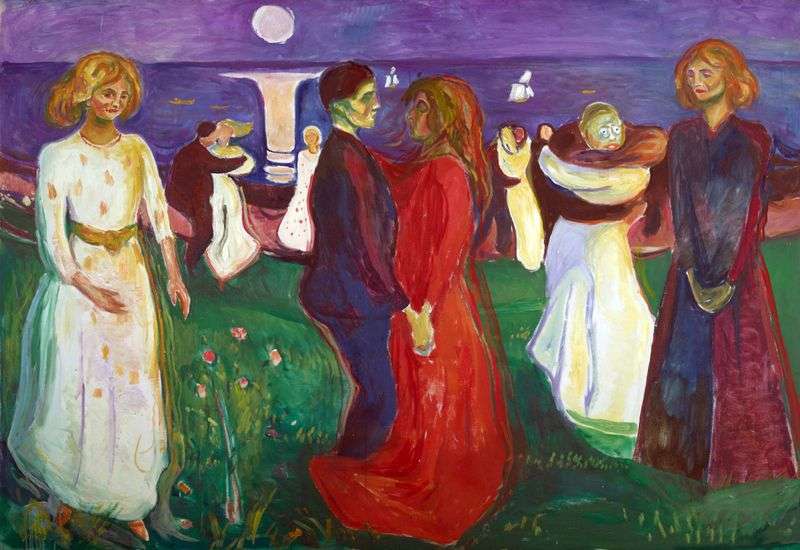
A significant number of works by the Norwegian artist E. Munk is represented at the National Museum of Art, Architecture and Design in Oslo. Along with the famous “Shout”, in the walls of the museum you can see an equally important cycle of paintings “The Frieze of Life: A Poem about Love, Life and Death.” The centerpiece of the cycle is Munch’s most important work, The Dance of Life.
Summer moon night. Couples whirl on the seashore in dance. At first glance, three female figures in white, red and black dresses attract attention.
The girl in white is standing alone, a little away from the dancers. A light sadness touched her face – after all, this evening she was alone at the celebration. But at the same time the girl is full of hopes for the future and is looking forward to the beginning of the dance of her life. She hesitantly extends her hand to a flower growing near her on a long, thin stalk. Bright girl personifies purity, innocence and innocence.
In the center – a woman in a bright red dress – dancing with a man, in the face of which one guesses a portrait resemblance to Munch himself. This is a mature woman. Her dance began a long time ago, an impatient youth was left behind, and now the woman calmly and steadily enjoys the present, realizing that old age will not take long to wait.
She stands right there, nearby, dressed in dark clothes and assuming the image of a sad woman in a black dress. In old age, as in youth, there is no dance partner this evening. Youth, happiness, ease and freedom remained only in her memories. Twisted, thin hands are powerlessly lowered; she looks at the dancers with a blank and even somewhat frightening look, devoid of all hope.
With its plot, the painting “Dance of Life” echoes another work of the Norwegian artist – “Three Ages of a Woman.” A young maid in white, a naked beauty and a mournful figure in mourning clothes are three faces in which a woman was depicted on her. Initially, the last picture Munch planned to put on the “Freeze…”, but eventually opted for “The Dance of Life.”
According to one of the versions, the play of the Danish symbolist H. Rohde, “In a whirlwind of waltz,” was the inspiration for writing a picture for the artist. According to another, the basis of “Dance…” was the real story from Munch’s life, connected with his first love, Milli Taulov. According to the Norwegian, it was the memories of her that pushed him to work on the painting. And the third version, which Munk biographers adhere to, links the emergence of the canvas with the relationship between the artist and Tulla Larsen. Each of the female figures is equally reminiscent of a portrait of a girl, written by Munk at the beginning of their romance. The girl in white is young Tulla, who nourished her hopes for the power of her love that could heal the artist, and the bored woman who lost her faith in black was Tulla, who acknowledged her defeat.
In addition to female and male figures, there is an interesting detail in the picture, which can not be seen immediately. Behind the dancers’ backs, a moonlit path stretched along the sea surface. In an effort to start her own dance, she connects with the moon, and together they form a human figure with open arms. The moon wants to merge with people and experience the feelings and emotions that they experience as they live every moment of their short dance of life.


